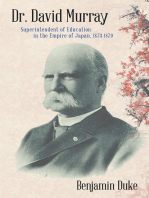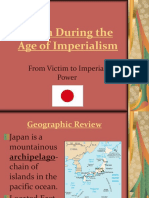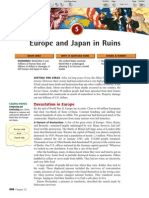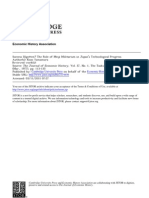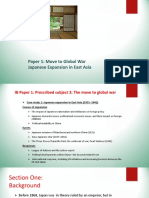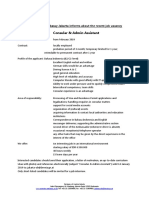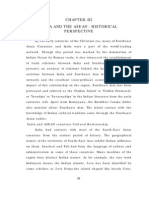CH 28 Sec 2 - Modernization in Japan
CH 28 Sec 2 - Modernization in Japan
Uploaded by
MrEHsiehCopyright:
Available Formats
CH 28 Sec 2 - Modernization in Japan
CH 28 Sec 2 - Modernization in Japan
Uploaded by
MrEHsiehOriginal Title
Copyright
Available Formats
Share this document
Did you find this document useful?
Is this content inappropriate?
Copyright:
Available Formats
CH 28 Sec 2 - Modernization in Japan
CH 28 Sec 2 - Modernization in Japan
Uploaded by
MrEHsiehCopyright:
Available Formats
Page 1 of 4
Modernization in Japan
MAIN IDEA
WHY IT MATTERS NOW
CULTURAL INTERACTION Japan
followed the model of Western
powers by industrializing and
expanding its foreign influence.
Japans continued development
of its own way of life has made
it a leading world power.
TERMS & NAMES
Treaty of
Kanagawa
Meiji era
RussoJapanese War
annexation
SETTING THE STAGE In the early 17th century, Japan had shut itself off from
almost all contact with other nations. Under the rule of the Tokugawa shoguns,
Japanese society was very tightly ordered. The shogun parceled out land to the
daimyo, or lords. The peasants worked for and lived under the protection of their
daimyo and his small army of samurai, or warriors. This rigid feudal system
managed to keep the country free of civil war. Peace and relative prosperity
reigned in Japan for two centuries.
TAKING NOTES
Analyzing Causes List
the steps that Japan
took toward
modernization and the
events that contributed
to its growth as an
imperialistic power.
Modernization
Imperialism
Japan Ends Its Isolation
The Japanese had almost no contact with the industrialized world during this
time of isolation. They continued, however, to trade with China and with Dutch
merchants from Indonesia. They also had diplomatic contact with Korea.
However, trade was growing in importance, both inside and outside Japan.
The Demand for Foreign Trade Beginning in the early 19th century,
Westerners tried to convince the Japanese to open their ports to trade. British,
French, Russian, and American officials occasionally anchored off the Japanese
coast. Like China, however, Japan repeatedly refused to receive them. Then, in
1853, U.S. Commodore Matthew Perry took four ships into what is now Tokyo
Harbor. These massive black wooden ships powered by steam astounded the
Japanese. The ships cannons also shocked them. The Tokugawa shogun realized
he had no choice but to receive Perry and the letter Perry had brought from U.S.
president Millard Fillmore.
Fillmores letter politely asked the shogun to allow free trade between the
United States and Japan. Perry delivered it with a threat, however. He would
come back with a larger fleet in a year to receive Japans reply. That reply was
the Treaty of Kanagawa of 1854. Under its terms, Japan opened two ports at
which U.S. ships could take on supplies. After the United States had pushed open
the door, other Western powers soon followed. By 1860, Japan, like China, had
granted foreigners permission to trade at several treaty ports. It had also
extended extraterritorial rights to many foreign nations.
Meiji Reform and Modernization The Japanese were angry that the shogun had
given in to the foreigners demands. They turned to Japans young emperor,
Mutsuhito (mootsooHEEtoh), who seemed to symbolize the countrys sense of
810 Chapter 28
Page 2 of 4
pride and nationalism. In 1867, the Tokugawa shogun stepped down, ending the military dictatorships that had lasted since the 12th century. Mutsuhito took control of
the government. He chose the name Meiji for his reign, which means enlightened
rule. Mutsuhitos reign, which lasted 45 years, is known as the Meiji era.
The Meiji emperor realized that the best way to counter Western influence was
to modernize. He sent diplomats to Europe and North America to study Western
ways. The Japanese then chose what they believed to be the best that Western civilization had to offer and adapted it to their own country. They admired Germanys
strong centralized government, for example. And they used its constitution as a
model for their own. The Japanese also admired the discipline of the German army
and the skill of the British navy. They attempted to imitate these European powers
as they modernized their military. Japan adopted the American system of universal
public education and required that all Japanese children attend school. Their teachers often included foreign experts. Students could go abroad to study as well.
The emperor also energetically supported following the Western path of industrialization. By the early 20th century, the Japanese economy had become as modern as any in the world. The country built its first railroad line in 1872. The track
connected Tokyo, the nations capital, with the port of Yokohama, 20 miles to the
south. By 1914, Japan had more than 7,000 miles of railroad. Coal production grew
from half a million tons in 1875 to more than 21 million tons in 1913. Meanwhile,
large, state-supported companies built thousands of factories. Traditional Japanese
industries, such as tea processing and silk production, expanded to give the country unique products to trade. Developing modern industries, such as shipbuilding,
made Japan competitive with the West.
Imperial Japan
Japans race to modernize paid off. By 1890, the country had several dozen warships and 500,000 well-trained, well-armed soldiers. It had become the strongest
military power in Asia.
Japan had gained military, political, and economic strength. It then sought to
eliminate the extraterritorial rights of foreigners. The Japanese foreign minister
assured foreigners that they could rely on fair treatment in Japan. This was because
its constitution and legal codes were similar to those of European nations, he
explained. His reasoning was convincing, and in 1894, foreign powers accepted the
China and Japan Confront the West
China
Remains committed
to traditional values
Loses numerous
territorial conflicts
Grants other
nations spheres of
influence within
China
Finally accepts
necessity for reform
The Dowager
Empress Cixi
(18621908)
Both
Have wellestablished
traditional
values
Initially resist
change
Oppose Western
imperialism
Japan
Considers
modernization to be
necessary
Borrows and adapts
Western ways
Strengthens its
economic and
military power
Becomes an empire
builder
SKILLBUILDER: Interpreting Charts
1. Contrasting According to the diagram, in what ways did China and Japan
deal differently with Western influence?
2. Comparing What similar responses did each country share despite the
different paths they followed?
The Meiji Emperor
Mutsuhito
(18671912)
811
Page 3 of 4
abolition of extraterritorial rights for their citizens living in Japan. Japans feeling
of strength and equality with the Western nations rose.
As Japans sense of power grew, the nation also became more imperialistic. As
in Europe, national pride played a large part in Japans imperial plans. The
Japanese were determined to show the world that they were a powerful nation.
Japan Attacks China The Japanese first turned their sights to their neighbor,
Korea. In 1876, Japan forced Korea to open three ports to Japanese trade. But
China also considered Korea to be important both as a trading partner and a military outpost. Recognizing their similar interests in Korea, Japan and China signed
a hands-off agreement. In 1885, both countries pledged that they would not send
their armies into Korea.
In June 1894, however, China broke that agreement. Rebellions had broken out
against Koreas king. He asked China for military help in putting them down.
Chinese troops marched into Korea. Japan protested and sent its troops to Korea to
fight the Chinese. This Sino-Japanese War lasted just a few months. In that time,
Japan drove the Chinese out of Korea, destroyed the Chinese navy, and gained a
foothold in Manchuria. In 1895, China and Japan signed a peace treaty. This treaty
gave Japan its first colonies, Taiwan and the neighboring Pescadores Islands. (See
the map on page 803.)
Russo-Japanese War Japans victory over China changed the worlds balance of
power. Russia and Japan emerged as the major powersand enemiesin East
Asia. The two countries soon went to war over Manchuria. In 1903, Japan offered
to recognize Russias rights in Manchuria if the Russians would agree to stay out
of Korea. But the Russians refused.
In February 1904, Japan launched a surprise attack on Russian ships anchored
off the coast of Manchuria. In the resulting Russo-Japanese War, Japan drove
Warlike Japan
Cartoonists often use symbols to identify the
countries, individuals, or even ideas featured in
their cartoons. Russia has long been symbolized
as a bear by cartoonists. Here, the cartoonist uses
a polar bear.
Prior to the Meiji era, cartoonists usually
pictured Japan as a fierce samurai. Later, however,
Japan often was symbolized by a caricature of
Emperor Mutsuhito. Here, the cartoonist has
exaggerated the emperors physical features to
make him look like a bird of prey.
SKILLBUILDER:
Interpreting Political Cartoons
1. Clarifying How does the cartoonist signify
that Japan is warlike?
2. Making Inferences In their fight, Russia
and Japan appear to be crushing someone.
Who do you think this might be?
812 Chapter 28
Making
Inferences
Why did
Japan become
imperialistic?
Vocabulary
Sino: a prefix meaning Chinese
Page 4 of 4
Russian troops out of Korea and captured most of Russias
Pacific fleet. It also destroyed Russias Baltic fleet, which had
sailed all the way around Africa to participate in the war.
In 1905, Japan and Russia began peace negotiations. U.S.
president Theodore Roosevelt helped draft the treaty, which
the two nations signed on a ship off Portsmouth, New
Hampshire. This agreement, the Treaty of Portsmouth, gave
Japan the captured territories. It also forced Russia to withdraw from Manchuria and to stay out of Korea.
Western Views of the East
The Japanese victory over the
Russians in 1905 exploded a strong
Western myth. Many Westerners
believed that white people were a
superior race. The overwhelming
success of European colonialism and
imperialism in the Americas, Africa,
and Asia had reinforced this belief.
But the Japanese had shown
Europeans that people of other races
were their equals in modern warfare.
Unfortunately, Japans military
victory led to a different form of
Western racism. Influenced by the
ideas of Germanys Emperor Wilhelm
II, the West imagined the Japanese
uniting with the Chinese and
conquering Europe. The resulting
racist Western fear of what was called
the yellow peril influenced world
politics for many decades.
Japanese Occupation of Korea After defeating Russia,
Japan attacked Korea with a vengeance. In 1905, it made
Korea a protectorate. Japan sent in advisers, who grabbed
more and more power from the Korean government. The
Korean king was unable to rally international support for his
regime. In 1907, he gave up control of the country. Within
two years the Korean Imperial Army was disbanded. In
1910, Japan officially imposed annexation on Korea, or
brought that country under Japans control.
The Japanese were harsh rulers. They shut down Korean
newspapers and took over Korean schools. There they
replaced the study of Korean language and history with
Japanese subjects. They took land away from Korean farmers and gave it to Japanese settlers. They encouraged
Japanese businessmen to start industries in Korea, but forbade Koreans from going into business. Resentment of Japans repressive rule
grew, helping to create a strong Korean nationalist movement.
The rest of the world clearly saw the brutal results of Japans imperialism.
Nevertheless, the United States and other European countries largely ignored what
was happening in Korea. They were too busy with their own imperialistic aims, as
you will learn in Section 3.
Vocabulary
protectorate: a
country under the
partial control and
protection of
another nation
Clarifying
How did Japan
treat the Koreans
after it annexed the
country?
SECTION
ASSESSMENT
TERMS & NAMES 1. For each term or name, write a sentence explaining its significance.
Treaty of Kanagawa
Meiji era
Russo-Japanese War
annexation
USING YOUR NOTES
MAIN IDEAS
CRITICAL THINKING & WRITING
2. Do you think that Japan could
3. How was the Treaty of
6. ANALYZING CAUSES What influences do you think were
have become an imperialistic
power if it had not modernized? Why or why not?
Modernization
Imperialism
Kanagawa similar to the
treaties that China signed with
various European powers?
4. What steps did the Meiji
emperor take to modernize
Japan?
5. How did Japan begin its quest
to build an empire?
most important in motivating Japan to build its empire?
7. FORMING AND SUPPORTING OPINIONS In your view, was
Japans aggressive imperialism justified? Support your
answer with information from the text.
8. ANALYZING BIAS How did Japans victory in the Russo-
Japanese War both explode and create stereotypes?
9. WRITING ACTIVITY EMPIRE BUILDING In the role of a
Japanese official, write a letter to the government of a
Western power explaining why you think it is necessary
for your country to build an empire.
CONNECT TO TODAY CREATING A SYMBOL
Conduct research to discover the name that Akihito, the present emperor of Japan, chose for
his reign. Then create a symbol that expresses the meaning of this name.
Transformations Around the Globe 813
You might also like
- Euwhoiswho Eeas enDocument22 pagesEuwhoiswho Eeas enmariangelesmillangutierrezNo ratings yet
- CH 27 Sec 4 - British Imperialism in IndiaDocument5 pagesCH 27 Sec 4 - British Imperialism in IndiaMrEHsieh100% (2)
- CH 27 Sec 4 - British Imperialism in IndiaDocument5 pagesCH 27 Sec 4 - British Imperialism in IndiaMrEHsieh100% (2)
- MeijiDocument18 pagesMeijiapi-283804229No ratings yet
- Meiji Restoration Bibliography Primary SourcesDocument4 pagesMeiji Restoration Bibliography Primary Sourcesapi-2725826490% (1)
- CH 13 Sec 3 - The Age of ChivalryDocument6 pagesCH 13 Sec 3 - The Age of ChivalryMrEHsieh100% (1)
- Modern History Summary Notes: Case Study 1: The Decline and Fall of The Romanov DynastyDocument13 pagesModern History Summary Notes: Case Study 1: The Decline and Fall of The Romanov DynastyconorNo ratings yet
- Dr. David Murray: Superintendent of Education in the Empire of Japan, 1873-1879From EverandDr. David Murray: Superintendent of Education in the Empire of Japan, 1873-1879No ratings yet
- II Jds - 5 - 1 - Kamuthanna PDFDocument15 pagesII Jds - 5 - 1 - Kamuthanna PDFdinpucioasaNo ratings yet
- Japan During The Age of ImperialismDocument20 pagesJapan During The Age of Imperialismapi-309710992No ratings yet
- The Meiji Restoration - Roots of Modern JapanDocument18 pagesThe Meiji Restoration - Roots of Modern Japanapi-308028465No ratings yet
- CH 31 Sec 3 - Fascism Rises in Europe PDFDocument5 pagesCH 31 Sec 3 - Fascism Rises in Europe PDFMrEHsieh100% (2)
- CH 33 Sec 4 - The Cold War Divides The World PDFDocument6 pagesCH 33 Sec 4 - The Cold War Divides The World PDFMrEHsiehNo ratings yet
- CH 31 Sec 1 - Postwar Uncertainty PDFDocument5 pagesCH 31 Sec 1 - Postwar Uncertainty PDFMrEHsiehNo ratings yet
- CH 35 Sec 5 - China Reform and Reaction PDFDocument5 pagesCH 35 Sec 5 - China Reform and Reaction PDFMrEHsieh100% (3)
- CH 32 Sec 4 - The Allied Victory PDFDocument8 pagesCH 32 Sec 4 - The Allied Victory PDFMrEHsiehNo ratings yet
- CH 29 Sec 3 - A Global Conflict PDFDocument6 pagesCH 29 Sec 3 - A Global Conflict PDFMrEHsieh100% (2)
- CH 30 Sec 3 - Imperial China Collapses PDFDocument5 pagesCH 30 Sec 3 - Imperial China Collapses PDFMrEHsiehNo ratings yet
- CH 32 Sec 5 - Europe and Japan in RuinsDocument4 pagesCH 32 Sec 5 - Europe and Japan in RuinsMrEHsiehNo ratings yet
- CH 23 Sec 2 - The Revolution Brings Reform and TerrorDocument6 pagesCH 23 Sec 2 - The Revolution Brings Reform and TerrorMrEHsieh100% (1)
- The Aims and Achievements of Mussolini's Social and Economic PoliciesDocument10 pagesThe Aims and Achievements of Mussolini's Social and Economic PoliciesJack UsherNo ratings yet
- CH 33 Sec 5 - The Cold War Thaws PDFDocument4 pagesCH 33 Sec 5 - The Cold War Thaws PDFMrEHsiehNo ratings yet
- CH 31 Sec 4 - Aggressors Invade Nations PDFDocument5 pagesCH 31 Sec 4 - Aggressors Invade Nations PDFMrEHsiehNo ratings yet
- CH 34 Sec 2 - Southeast Asian Nations Gain Independence PDFDocument6 pagesCH 34 Sec 2 - Southeast Asian Nations Gain Independence PDFMrEHsieh0% (1)
- CH 23 Sec 4 - Napoleon's Empire CollapsesDocument4 pagesCH 23 Sec 4 - Napoleon's Empire CollapsesMrEHsieh100% (1)
- CH 21 Sec 1 - Spain's Empire and European AbsolutismDocument7 pagesCH 21 Sec 1 - Spain's Empire and European AbsolutismMrEHsiehNo ratings yet
- Unit-9 Japan Transition To ModernizationDocument12 pagesUnit-9 Japan Transition To ModernizationAadil ManZoorNo ratings yet
- CH 32 Sec 2 - Japan's Pacific Campaign PDFDocument5 pagesCH 32 Sec 2 - Japan's Pacific Campaign PDFMrEHsieh100% (2)
- Military Modernization of JapanDocument10 pagesMilitary Modernization of JapanRamita UdayashankarNo ratings yet
- CH 29 Sec 1 - Marching Towards War PDFDocument4 pagesCH 29 Sec 1 - Marching Towards War PDFMrEHsieh100% (2)
- The Industrial Rev NotesDocument4 pagesThe Industrial Rev Notesʚĩ FàDìâ Ĩɞ100% (1)
- CH 10 Sec 1 - The Rise of Islam PDFDocument6 pagesCH 10 Sec 1 - The Rise of Islam PDFJ. NievesNo ratings yet
- The American Revolution: Essential QuestionDocument41 pagesThe American Revolution: Essential Questionizzy biggs100% (2)
- CH 23 Sec 5 - The Congress of ViennaDocument4 pagesCH 23 Sec 5 - The Congress of ViennaMrEHsieh100% (2)
- Chapter 26 The Great Depression PowerpointDocument39 pagesChapter 26 The Great Depression Powerpointapi-178733215No ratings yet
- CH 32 Sec 1 - Hitler's Lightning War PDFDocument6 pagesCH 32 Sec 1 - Hitler's Lightning War PDFMrEHsieh100% (2)
- Cambridge University Press Economic History AssociationDocument24 pagesCambridge University Press Economic History AssociationmahamidahmedNo ratings yet
- Chap 23Document32 pagesChap 23api-240900456No ratings yet
- CH 23 Sec 1 - The French Revolution BeginsDocument5 pagesCH 23 Sec 1 - The French Revolution BeginsMrEHsieh100% (1)
- CH 34 Sec 3 - New Nations in Africa PDFDocument5 pagesCH 34 Sec 3 - New Nations in Africa PDFMrEHsiehNo ratings yet
- CH 25 Sec 3 - Industrialization SpreadsDocument5 pagesCH 25 Sec 3 - Industrialization SpreadsMrEHsiehNo ratings yet
- CH 12 Sec 4 - Feudal Powers in JapanDocument5 pagesCH 12 Sec 4 - Feudal Powers in JapanMrEHsiehNo ratings yet
- Progressive Era Reforms PowerpointDocument16 pagesProgressive Era Reforms Powerpointapi-209089079No ratings yet
- CH 11 Sec 3 - Turkish Empires Rise in AnatoliaDocument4 pagesCH 11 Sec 3 - Turkish Empires Rise in AnatoliaMrEHsieh100% (2)
- 07 - World War I PDFDocument54 pages07 - World War I PDFHugh AlexanderNo ratings yet
- The USA 1919 - 1941 The USA During and After WW1Document7 pagesThe USA 1919 - 1941 The USA During and After WW1Zahra murtuzaNo ratings yet
- CH 34 Sec 1 - The Indian Subcontinent Achieves Freedom PDFDocument7 pagesCH 34 Sec 1 - The Indian Subcontinent Achieves Freedom PDFMrEHsiehNo ratings yet
- Totalitarianism: CASE STUDY: Stalinist RussiaDocument6 pagesTotalitarianism: CASE STUDY: Stalinist RussiaDevito Wallace100% (1)
- Political Problems of The: Weimar RepublicDocument15 pagesPolitical Problems of The: Weimar RepublicAnonymous ZOzTRxM1EoNo ratings yet
- Indian IndependenceDocument41 pagesIndian Independencekaranpreet singhNo ratings yet
- CH 35 Sec 4 - Changes in Central and Eastern Europe PDFDocument7 pagesCH 35 Sec 4 - Changes in Central and Eastern Europe PDFMrEHsiehNo ratings yet
- Financial Stabilization in Meiji Japan: The Impact of the Matsukata ReformFrom EverandFinancial Stabilization in Meiji Japan: The Impact of the Matsukata ReformNo ratings yet
- Gr10 Imp Asia L1 Patterns of Interaction Chapter-28 Meiji JapanDocument4 pagesGr10 Imp Asia L1 Patterns of Interaction Chapter-28 Meiji JapanAdit JNo ratings yet
- Rise of Japan ReadingDocument9 pagesRise of Japan ReadingilonzokidsNo ratings yet
- Grudic Japan Move To Global War Japan 1.1Document42 pagesGrudic Japan Move To Global War Japan 1.1MasaNo ratings yet
- HIST103 5.3.3 JapaneseImperialism FINALDocument3 pagesHIST103 5.3.3 JapaneseImperialism FINALJohnNo ratings yet
- Sino Japanese WarDocument9 pagesSino Japanese WarOyeleye TofunmiNo ratings yet
- WHP-1750 3-2-5 Read - Meiji Restoration - 940LDocument8 pagesWHP-1750 3-2-5 Read - Meiji Restoration - 940LPoco ChanNo ratings yet
- Written Report Natiinalism AndexpansionismDocument4 pagesWritten Report Natiinalism AndexpansionismRamon Louis RepaldaNo ratings yet
- Week5 Hour 1Document3 pagesWeek5 Hour 1Kemale ZamanliNo ratings yet
- Japaneseimperialism 1Document3 pagesJapaneseimperialism 1api-267874922No ratings yet
- Japanese Imperialism (19th Century To 2nd World War)Document6 pagesJapanese Imperialism (19th Century To 2nd World War)Saniya PopliNo ratings yet
- Chapter1 - Case Study1 - JapanDocument22 pagesChapter1 - Case Study1 - JapanHenrique Abreu100% (1)
- CH 14 Sec 2 - Changes in Medieval SocietyDocument6 pagesCH 14 Sec 2 - Changes in Medieval SocietyMrEHsiehNo ratings yet
- CH 12 Sec 4 - Feudal Powers in JapanDocument5 pagesCH 12 Sec 4 - Feudal Powers in JapanMrEHsiehNo ratings yet
- ch13 2 PDFDocument6 pagesch13 2 PDFMohmad YousufNo ratings yet
- The Scramble For AfricaDocument6 pagesThe Scramble For Africajakila100% (2)
- CH 34 Sec 3 - New Nations in Africa PDFDocument5 pagesCH 34 Sec 3 - New Nations in Africa PDFMrEHsiehNo ratings yet
- CH 35 Sec 5 - China Reform and Reaction PDFDocument5 pagesCH 35 Sec 5 - China Reform and Reaction PDFMrEHsieh100% (3)
- M5C11EADDocument4 pagesM5C11EADDaniela ScobarNo ratings yet
- CH 36 Sec 1-4 - Global Interdependence PDFDocument26 pagesCH 36 Sec 1-4 - Global Interdependence PDFMrEHsiehNo ratings yet
- CH 34 Sec 1 - The Indian Subcontinent Achieves Freedom PDFDocument7 pagesCH 34 Sec 1 - The Indian Subcontinent Achieves Freedom PDFMrEHsiehNo ratings yet
- CH 36 Sec 1 - The Impact of Science and Technology PDFDocument4 pagesCH 36 Sec 1 - The Impact of Science and Technology PDFMrEHsiehNo ratings yet
- CH 27 Sec 3Document5 pagesCH 27 Sec 3api-263257778No ratings yet
- CH 34 Sec 2 - Southeast Asian Nations Gain Independence PDFDocument6 pagesCH 34 Sec 2 - Southeast Asian Nations Gain Independence PDFMrEHsieh0% (1)
- CH 24 Sec 4 - Revolution in The Arts PDFDocument4 pagesCH 24 Sec 4 - Revolution in The Arts PDFJ. NievesNo ratings yet
- CH 30 Sec 3 - Imperial China Collapses PDFDocument5 pagesCH 30 Sec 3 - Imperial China Collapses PDFMrEHsiehNo ratings yet
- CH 32 Sec 4 - The Allied Victory PDFDocument8 pagesCH 32 Sec 4 - The Allied Victory PDFMrEHsiehNo ratings yet
- CH 35 Sec 4 - Changes in Central and Eastern Europe PDFDocument7 pagesCH 35 Sec 4 - Changes in Central and Eastern Europe PDFMrEHsiehNo ratings yet
- CH 32 Sec 1 - Hitler's Lightning War PDFDocument6 pagesCH 32 Sec 1 - Hitler's Lightning War PDFMrEHsieh100% (2)
- CH 29 Sec 3 - A Global Conflict PDFDocument6 pagesCH 29 Sec 3 - A Global Conflict PDFMrEHsieh100% (2)
- CH 31 Sec 4 - Aggressors Invade Nations PDFDocument5 pagesCH 31 Sec 4 - Aggressors Invade Nations PDFMrEHsiehNo ratings yet
- CH 32 Sec 2 - Japan's Pacific Campaign PDFDocument5 pagesCH 32 Sec 2 - Japan's Pacific Campaign PDFMrEHsieh100% (2)
- CH 32 Sec 3Document4 pagesCH 32 Sec 3api-263257778100% (1)
- CH 33 Sec 5 - The Cold War Thaws PDFDocument4 pagesCH 33 Sec 5 - The Cold War Thaws PDFMrEHsiehNo ratings yet
- CH 32 Sec 5 - Europe and Japan in RuinsDocument4 pagesCH 32 Sec 5 - Europe and Japan in RuinsMrEHsiehNo ratings yet
- CH 26 Sec 3 - War and Expansion in The United StatesDocument4 pagesCH 26 Sec 3 - War and Expansion in The United StatesMrEHsiehNo ratings yet
- CH 29 Sec 1 - Marching Towards War PDFDocument4 pagesCH 29 Sec 1 - Marching Towards War PDFMrEHsieh100% (2)
- CH 36 AssessmentDocument2 pagesCH 36 AssessmentMrEHsiehNo ratings yet
- Policy Review 6373161 1636442561Document8 pagesPolicy Review 6373161 1636442561Aidah Md SaidNo ratings yet
- OPIL Consular Law and Practice Part II Consular Relations in General 4 Consular Relations and Consular Posts LDocument34 pagesOPIL Consular Law and Practice Part II Consular Relations in General 4 Consular Relations and Consular Posts LTatu PodliszewskiNo ratings yet
- Crafting Peace in A Turbulent WorldDocument2 pagesCrafting Peace in A Turbulent Worldfrank N.LNo ratings yet
- Pakistan Foreign Policy ChallangesDocument4 pagesPakistan Foreign Policy ChallangesJawad JuttNo ratings yet
- China's Foreign PolicyDocument6 pagesChina's Foreign PolicyBreaking Bad0% (1)
- Triple Intervention PDFDocument3 pagesTriple Intervention PDFdzimmer6No ratings yet
- U Seful Inform Ation: Useful InformationDocument2 pagesU Seful Inform Ation: Useful InformationAakashMalhotraNo ratings yet
- Ayoob Geostrategic SignificanceDocument14 pagesAyoob Geostrategic SignificanceachendkeNo ratings yet
- What Is Cold WarDocument8 pagesWhat Is Cold WarRukhsar TariqNo ratings yet
- Romerstein+ +Soviet+Agents+of+Influence 0Document38 pagesRomerstein+ +Soviet+Agents+of+Influence 0Fábio CoelhoNo ratings yet
- Case Concerning Kasikili/Sedudu Island (Botswana/Namibia)Document111 pagesCase Concerning Kasikili/Sedudu Island (Botswana/Namibia)Alvi SadewoNo ratings yet
- Annual Report Mea PDFDocument387 pagesAnnual Report Mea PDFIshan JhaNo ratings yet
- Smart PowerDocument9 pagesSmart Poweralpha_beta300No ratings yet
- Preserving The Unipolar Michael Mastanduno Moment - Realist Theories and U.S. Grand Strategy After The Cold WarDocument40 pagesPreserving The Unipolar Michael Mastanduno Moment - Realist Theories and U.S. Grand Strategy After The Cold WarrodolfoNo ratings yet
- Unipolar Vs MultipolarDocument22 pagesUnipolar Vs Multipolarbindu100% (2)
- Challenges To Multilateralism in South ADocument174 pagesChallenges To Multilateralism in South ACaio CesarNo ratings yet
- Chapter 22 Apush Study GuideDocument5 pagesChapter 22 Apush Study GuideCarol LeeNo ratings yet
- The Globalisation of The Cold WarDocument31 pagesThe Globalisation of The Cold WarIkra Saleem KhanNo ratings yet
- Ms. Takagi Yoko Ms. Satoko Oka NorimatsuDocument2 pagesMs. Takagi Yoko Ms. Satoko Oka NorimatsuKazuya AsakawaNo ratings yet
- Trade Promotion Manual For Ethiopian DiplomaticDocument132 pagesTrade Promotion Manual For Ethiopian DiplomatictilahunthmNo ratings yet
- The Rise of China and The US-Western Europe Alliance A Crack in The Liberal BuildingDocument24 pagesThe Rise of China and The US-Western Europe Alliance A Crack in The Liberal Buildingmbravo0906No ratings yet
- David Kang Tribute System in Early Modern East Asia 1Document32 pagesDavid Kang Tribute System in Early Modern East Asia 1KyleusthéticNo ratings yet
- United Nations General Assembly (UNGA) - UPSC NotesDocument3 pagesUnited Nations General Assembly (UNGA) - UPSC NotesAdwitiya MishraNo ratings yet
- Contoh Job VacancyDocument2 pagesContoh Job VacancyMargaretha LuvyluvNo ratings yet
- The History of Cultural DiplomacyDocument7 pagesThe History of Cultural DiplomacyvalistaNo ratings yet
- 11 Chapter 3Document41 pages11 Chapter 3gjithu16No ratings yet
- JOSEPH NYE - How Not To Deal With A Rising ChinaDocument17 pagesJOSEPH NYE - How Not To Deal With A Rising ChinaDanilo R. SousaNo ratings yet
- The ASEAN Free Trade AreaDocument3 pagesThe ASEAN Free Trade AreaWihl Mathew ZalatarNo ratings yet






